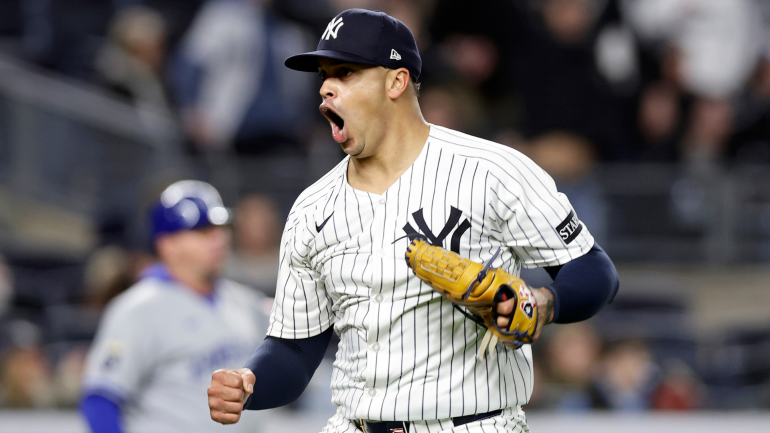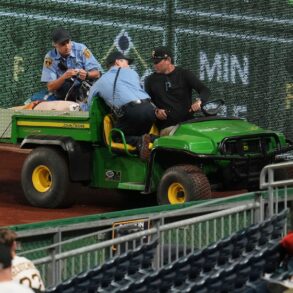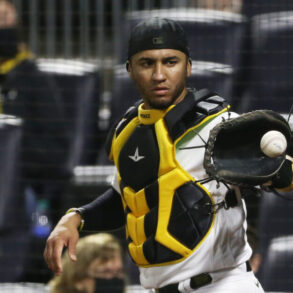
Major League Baseball’s regular season is now more than a month old, making this the time of the year when people begin to contemplate players’ statistics with more seriousness. Granted, the samples remain small. But, whenever a player’s output greatly deviates from expectations for this long, it’s only natural that folks start wondering what, precisely, is going on.
To honor that curiosity, I’m breaking down five pitchers who are playing better or worse than expected — on the rise or under the tide. I’ve attempted to explain the player’s performance to date, but, just as importantly, I’ve issued a verdict on what to expect from them heading forward.
With all that fine print out of the way, let’s get to business.
Pitchers on the rise
1. Fernando Cruz, RHP, New York Yankees
It’s not often that I include a 35-year-old in my breakout players column. I made an exception for Cruz, who entered the season with a career 4.52 ERA (100 ERA+) in 141 big-league appearances. You may recall that the Yankees nabbed Cruz from the Cincinnati Reds as part of the trade that sent catcher Jose Trevino to the midwest.
Cruz’s change of scenery encouraged me, since I felt the Yankees likely had some alterations in mind when they executed the deal. Here’s part of what I wrote back in February:
I have to imagine the Yankees are going to have Cruz ditch his ineffective cutter, the pitch responsible for nine of his 15 home runs allowed the last two seasons. Simultaneously, I expect Cruz to ramp up the usage of his splitter, in the spirit of how the Yankees had Tommy Kahnle spam his changeup. (Said splitter has held opponents to a .353 OPS over the last two years.) Should those tweaks occur, Cruz could emerge as a high-leverage weapon for Aaron Boone and the defending American League champs.
The Yankees did indeed see the same issues I identified, with Cruz making the exact tweaks I thought he might: spamming the splitter (56.4% usage rate) and seldom throwing the slider. In turn, he’s sporting a 1.45 ERA (278 ERA+) through 15 appearances.
While it’s never wise to read too much into a reliever’s statline after a month-plus of the season, I’ve been and remain a believer in Cruz as a viable high-leverage arm. His marks will likely regress to some extent, but I think this new formula will keep him in Boone’s circle of trust.
2. Matthew Liberatore, LHP, St. Louis Cardinals
Liberatore was the main piece the Cardinals received in the Randy Arozarena trade more than five years ago. You can be forgiven if it feels like more time has passed. After all, Arozarena enjoyed a successful run with the Rays before being traded, again, last deadline to the Seattle Mariners. Everyone has long since declared the deal a bust for the Cardinals, but the inconvenient truth is that the trade may still pay serious dividends for St. Louis. Be that from Tink Hence, the pitcher they selected with the draft pick they gained in the swap, or yes, from the southpaw de jour.
Liberatore won a rotation spot this spring after spending most of last year in the bullpen. He’s since entrenched himself by posting a 123 ERA+ and a 10 strikeout-to-walk ratio and averaging nearly six innings per pop across his first six starts. Furthermore, his 0.6 Wins Above Replacement is more than he had tallied over the course of his initial 91 big-league appearances.
The main difference in Liberatore’s game this year is that he’s prioritized using his slider as his go-to offering. It’s his best pitch at generating swings and misses, and he’s comfortable using it against lefties and righties alike. Otherwise? Liberatore’s success can be credited to his control over a slew of average or worse pitches, including two kinds of fastballs and a cutter.
Is Liberatore going to continue to front the Cardinals rotation? No, I wouldn’t think so. But a lefty who can throw strikes with a broad arsenal is never going to want for opportunity.
3. Max Meyer, RHP, Miami Marlins
Meyer was a personal favorite entering the 2020 draft: a small, athletic right-hander from Minnesota with a devastating slider. He’s since dealt with his share of injuries and setbacks, limiting him to 13 big-league appearances over his first four-plus years as a professional. He’s making up for lost time thus far this season, tallying a 114 ERA+ and a 3.62 strikeout-to-walk ratio over the course of his first seven times through the rotation.
Meyer is clearly a different pitcher now than he was even last season. Three of his pitches (his four-seamer, sinker, and changeup) have significantly altered shapes and added velocity, and he’s introduced a sweeper that offers even more gloveside movement than his signature slider. He’s using five pitches at least 10% of the time, giving him more looks to throw at the opposition than he did previously, when he was predominantly a fastball-slider pitcher with an occasional change.
For as good as that sounds, you might wonder if there’s reason for concern about Meyer’s propensity for allowing loud contact — he ranks in the 14th percentile in hard-hit percentage. I do find it reassuring that said contact tends to happen outside of the proverbial danger zone. Put another way, no pitcher surrenders a lower percentage of their 95 mph-plus batted balls within the 10 to 30 degree window than Meyer does. It’s to be seen if that holds up, but he has plenty working in his favor and I’d like to think that he’ll continue to be an above-average starter.
Pitchers under the tide
4. Tanner Houck, RHP, Boston Red Sox
Here’s the easiest way to sum up Houck’s season. Last year, when he made his first All-Star Game, he surrendered 11 home runs in 178 ⅔ innings. This season, he’s already given up seven home runs in 36 ⅔ innings. (That includes three more homers against his sinker than in 2024.) Some regression was to be expected after only three other qualified pitchers surrendered fewer long balls per nine last year, but this is so far in the other direction as to be laughable.
Houck’s main secondary pitches, his sweeper and splitter, have both been less effective — in part because of lesser location. It’s interesting to note that Houck is attempting to reintroduce a four-seamer to his arsenal after mothballing the pitch last year. He’s doing that while also completely phasing out a cutter that, as recently as 2023, had served as a bridge between his sweeper and the rest of his (armside moving) arsenal. The fastball doesn’t seem particularly good on its merits, and it’s mostly been used as a waste pitch above the zone (without success, I’ll note).
Even with all that established, I think Houck will get everything ironed out. He’s not going to continue serving up long balls at this frequency, and the rest of his peripherals look a lot like last season. That doesn’t mean Houck is going to pitch on an All-Star-level again; it does mean he’s not likely to remain one of the worst pitchers in the majors.
5. Dylan Cease, RHP, San Diego Padres
Cease is expected to be one of the top free-agent starters available this winter. He’s begun his platform year in rough fashion, however, averaging fewer than five innings per through seven starts. His walk rate is up and his strikeout rate would represent his worst since 2020. (For what it’s worth, fellow free-agent classmates Zac Gallen and Framber Valdez haven’t started hot, either.)
Cease has a few notable happenings going on underneath the hood. He’s lowered his arm angle, causing his four-seamer to feature more armside movement — usually, the pitch is more vertically orientated. Cease’s sweeper is lacking the same depth it showed last season, and he’s clearly struggling to locate his curveball where he wants it, causing him to throw just 45.8% of the offering for strikes (as opposed to more than 56% in each of the last two years).
The funny thing is that a lot of Cease’s underlying measures look similar to last season. He’s generating a hair more chases; he’s allowing more contact, but most of that is coming outside the zone; and he’s even throwing about the same proportion of pitches in the zone. It goes to show that twin inputs don’t always breed the same outputs, at least over small samples.
As with Houck, I have to believe Cease will correct his course before long. For now, though, this free-agent class does look less impressive than it did a month ago.
This post was originally published on this site be sure to check out more of their content.





